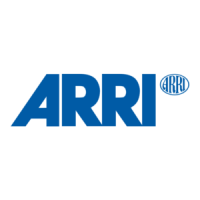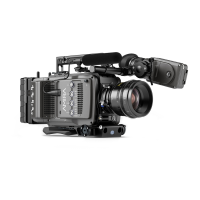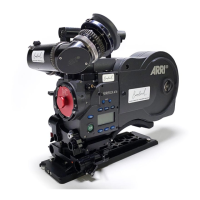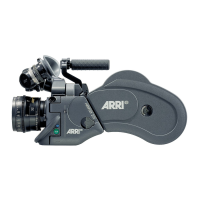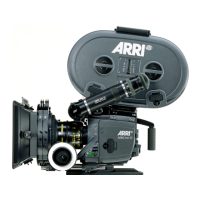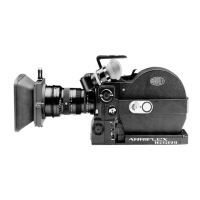Setup: The sound department acts as the timecode master, and
generates timecode which uses the time of day as a value, and a
time base matching the project frame rate. Twenty-four hours of
time will translate into twenty-four hours of time code.
Timecode is fed to the camera via the TC connector. The
timecode source must be set in the camera to Ext LTC and the
mode to Free Run. The project fps setting must match both the
sensor frame rate and the time base of the external timecode
signal. The camera can be set to use Jam sync generator, in
which it samples the timecode value once and then continues
counting based on its own high-precision crystal clock. The
timecode source can be disconnected from the camera after
jamming in Jam sync generator mode. This mode ensures stable
timecode with an offset of less than one frame for each eight
hours, after which the camera has to be re-jammed.
Alternatively, the camera can be set to regenerate mode, or
Regen on the TIMECODE OPTIONS screen. In Regen mode, the
camera uses the timecode value of the external timecode source.
This ensures correct timecode for an infinite duration, but the
timecode source must remain connected to the camera. Note
that the camera ignores external timecode during record and
counts using its internal clock to avoid timecode jumps should
connection problems arise, e. g. due to a faulty timecode cable.
Variations: If shooting starts close to midnight, the timecode
might be started with an offset time of day to prevent a rollover
at midnight.
Restrictions: External timecode is only possible if the camera is
running at sync-sound speed. If the camera is over- or under-
cranking, the timecode frame rate will no longer match the
sensor framerate, and timecode values would either be duplicate
or dropped. To prevent this, the ALEXA will automatically switch
to Int TC source and Regen mode when the sensor frame rate is
changed.
Internal TC, Rec Run
Use: Record run timecode is often used on single camera
productions that are either MOS or use a dumb slate to sync
picture and sound. Record run timecode guarantees continuous
timecode on all recorded data. Record runtime code also works
with over- and under-cranking.
Setup: The timecode source must be set to Int TC, the mode to
Rec Run and the generator to Regen. Timecode counts up only
during recording, by one frame for each image generated by the
sensor. The timecode counts at the project frame rate set on the
camera. Normally, the timecode hour value advances by one
hour for each new reel, using only hours 01-20 for reel 1-20, and
then restarting at hour 01 for reel 21.
Variations: Record run timecode might be used for off-speed
work on productions that use external timecode sources for all
sync sound

